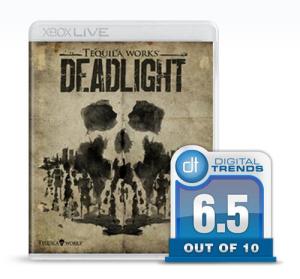 I’ve never had a “running from zombies” nightmare that ended with me being eaten because my body stopped responding to my brain, but I expect that things will now be different after playing through Tequila Works’ Deadlight. The post-zombie apocalyptic survival game may boast some exceedingly high production values, but its collection of beautiful dystopian tableaus aren’t enough to prevent you from frequently dropping your controller in frustration as you succumb to another horde of zombies — or “Shadows” as they’re called in the game — or another poorly timed jump.
I’ve never had a “running from zombies” nightmare that ended with me being eaten because my body stopped responding to my brain, but I expect that things will now be different after playing through Tequila Works’ Deadlight. The post-zombie apocalyptic survival game may boast some exceedingly high production values, but its collection of beautiful dystopian tableaus aren’t enough to prevent you from frequently dropping your controller in frustration as you succumb to another horde of zombies — or “Shadows” as they’re called in the game — or another poorly timed jump.
Deadlight has been framed throughout its development as a side-scrolling survival horror game, but the game really has more in common with old-school platformers like Mega Man or Prince of Persia than it does with the likes of Silent Hill or Resident Evil. Sure, there’s a bit of resource management and you’re constantly fighting with the clunky controls — not by design, I would wager — but you’ll more often than not find during the exceedingly brief two-hour play time that the biggest challenge you face is a tired gauntlet of trial-and-error repetition. There’s certainly an audience for that sort of interactive experience, though the Mega Man 10-loving mutants of the world will probably find Deadlight just a bit too easy for their tastes.
The story is set in an alternate 1986, opening a world that’s been ravaged by some unspecified plague that turns average humans into mindless, cannabalistic beasts. One bite from an infected Shadow is enough to doom a person to the same fate. These Shadows are slow movers until they find a food source, at which point they lift themselves up and assemble into a shambling horde. So yes, while the game never once uses the Z-word, we are, for all intents and purposes, dealing with zombies here.

The 1986 setting adds a cool dynamic, since turning the clock back to a pre-Internet age allows Tequila Works to avoid having to explain away potential lifelines like cellular service and global positioning systems. The world’s infrastructure completely collapses when the Shadows take over, and many of the more well-armed survivors band together to create a New World Order for themselves. All of this plays out at the periphery of the story, mind you; there are some encounters with unfriendly humans in the late-game, but most of the challenges that you’re tackling involve puzzles built around the environment and the behaviors of the Shadows.
Deadlight is strongest in the presentation department. The side-scrolling action benefits from a highly stylized dose of photorealism that leans heavily in the direction of silhouette and shadow play. That visual aesthetic is sometimes detrimental to the play, since it’s easy to overlook important Next Steps for a given puzzle when the solution is a slightly lighter-colored bit of shadowy scenery against a background of darker shades. The visual execution is impressive overall though, and it helps ease the frustration of uncooperative controls.
I’d also have words of praise for the overarching narrative if the moment-to-moment writing didn’t feel so clumsy and, occasionally, at odds with the sharp visual presentation. No spoilers, but there’s a reason you’re running and leaping your way through the ruins of Seattle, something with a bit more substance than “escape the zombies.” The big picture plot points take some well-earned turns, but the writing around the dialogue and monologuing is clunky at best, mood-killingly laughable at worst. The game’s final cutscene is perhaps the biggest offender, which is a shame since it’s also meant to be the point at which all of the story’s scattered pieces come together.
The biggest obstacle to having fun, however, is how the game controls. If you’ve played any of the older, side-scrolling Prince of Persia games, then Deadlight should feel immediately familiar. There’s a fatigue meter that limits how much time you can spend dangling by your arms and how many times you can swing your axe at approaching Shadows, but the basics of running, jumping, and climbing are definitely in the style of the older game.

Of course, “later on” is a relative term when applied to Deadlight, since you can easily finish the game in approximately two hours (my own playthrough clocked in at 1hr 58min). There’s not much to come back for either. Most of the levels hide an assortment of collectibles, the best of which are three unlockable handheld video games in the style of Tiger’s handhelds from the ’80s and ’90s. You can play with these in a separate mode once they’re unlocked, and the strong visual style carries over with physical handheld being represented on your screen as you play. You’ll also, oddly, pick up ID cards for dead serial killers as you explore… for some unknown reason.
There are some good ideas here, and some strong talents at work in the realms of art design and story writing, but the overall experience amounts to less than the sum of those parts. The survival horror messaging from early previews might have gotten it wrong, but the real crimes here are clunky controls and ambience-shattering writing. Putting two hours into Deadlight isn’t a waste of time, but it ‘s definitely disappointing to see the dream of the game’s Shadow Complex-meets-zombies aesthetic transform into the stuff of nightmares.
Score: 6.5 out of 10
(This game was reviewed on the Xbox 360 on a copy provided by Microsoft Studios)


